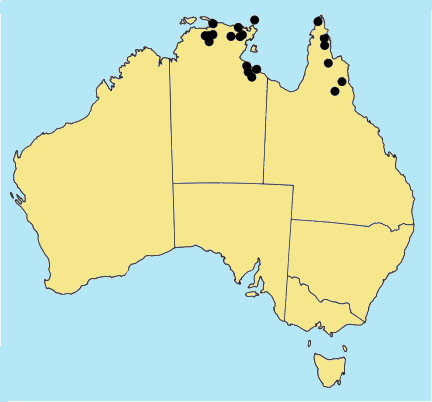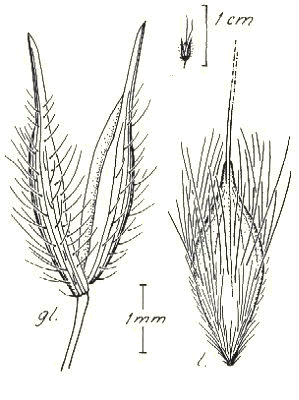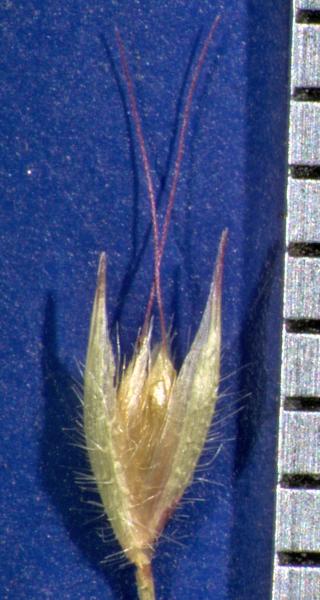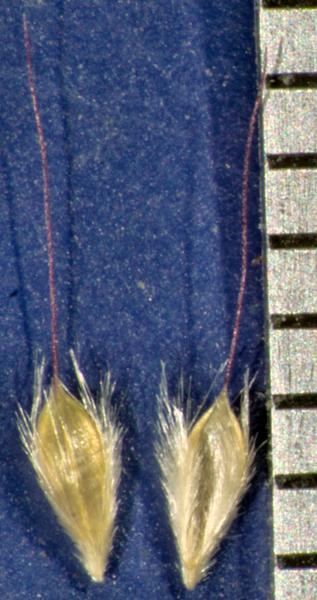Eriachne filiformis Hartley. J.Linn.Soc.,Bot.52:343(1942).
Classification. (GPWG 2001) : Subfamily Micrairoideae. Eriachneae.
Type of Basionym or
Protologue Information: HT: H. Basedow 81, Apr-Jun 1928, Australia:
Northrn Territory: Darwin and Gulf District: Arnhem Land (K; IT: AD, BRI).
Key references
(books and floras): [2002] D.Sharp & B.K.Simon, AusGrass, Grasses of
Australia.
Illustrations:
[2005] K.Mallet (ed.), Flora of Australia 44B: Poaceae 3 (Fig.
27C-D).
Habit. Annual
or ephemeral. Culms erect, stature slender to delicate, 3–60 cm tall, 2–4
-noded. Mid-culm nodes glabrous or pubescent or bearded. Lateral branches
branched. Leaf-sheaths hairy. Ligule a fringe of hairs. Leaf-blades filiform,
involute, 2–5 cm long, 0.5 mm wide. Leaf-blade surface indumented.
Inflorescence.
Inflorescence compound, a panicle. Panicle ovate, 0.5–2 cm long, 0.8–1 cm wide.
Spikelets.
Spikelets pedicelled. Fertile spikelets 2-flowered, both fertile, comprising 2
fertile floret(s), without rachilla extension, ovate, laterally compressed, 3–5
mm long.
Glumes. Glumes
similar, thinner than fertile lemma. Lower glume elliptic or oblong,
membranous, without keels, 9–11 -nerved. Lower glume surface indumented. Upper
glume elliptic or oblong, 3–5 mm long, membranous, without keels, 9–11 -nerved.
Upper glume surface indumented.
Florets.
Fertile lemma 2–4 mm long, without keel, 5–7 -nerved. Lemma surface indumented.
Lemma apex awned, 1 -awned. Median (principal) awn 2–6(–8) mm long overall.
Palea apex entire or erose, muticous. Grain 1–3 mm long.
Continental
Distribution: Australasia.
Australian
Distribution: Northern Territory, Queensland.
Northern Territory:
Darwin & Gulf. Queensland: Cook.
Notes.
Distinguishing features include the extremely slender short-lived habit, mainly
basal leaves and setaceous blades, sparse panicles prominently exserted on
capillary peduncles much longer than the culm internodes, long-acuminate or
beaked, hispid or tubercled glumes, florets shorter than glumes with appressed
lemma and palea, acute or subacute callus, grooveless awned lemmas concealed by
indumentum, beaked sometimes glabrous palea and thin shiny caryopsis. E.
filiformis has similarities to E. agrostidea, E. humilis and E.
capillaris. Its distinguishing features are discussed under the individual
species.
Endemic.
N of 17ºS on mainland and islands in Qld and N.T. Damp and seasonally wet sites
such as floodplains, small watercourses, seepage, and broad shallow
depressions, in fine-textured, often white sand, silty sand and sandy loam;
recorded also from well-drained lateritic gravel, sand-filled cracks,
creeklines on rocky sandstone hills and plateaux, and margins of Melaleuca
swamps. Flowers and fruits Apr.-July (autumn and winter), and sometimes in Oct.
(mid-spring).






